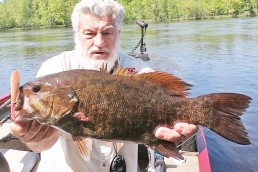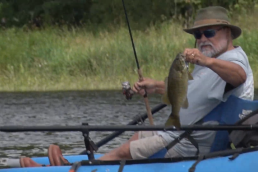Topwater for Post-Spawn River Smallmouth
SHARE THIS POST
Over the past 40 years of guiding for smallmouth bass I have refined topwater presentations for river smallmouths. If anglers learn to tweak their presentation and adjust to both the conditions and mood of smallmouths, they can increase their odds. There can be an awesome topwater bite on the river for post-spawn smallmouths if you get things just right.
Last June, after smallmouth bass spawning was complete, the water level on the Menominee River started to rise. Rising water will either push smallmouths into deep, snag-infested holes or tight to shoreline wood.
Smallmouths which gravitate to deep water tend to be in a negative feeding mood and hunker down tight to cover. This makes fishing tough and it is not an ideal situation for a guide. The only reliable pattern is to cast a tube, rigged weedless, right in the thick of things. While I have spent many a day on the river dragging tubes over deep cover and caught lots of smallmouth, this can be frustrating for many anglers. There is another option.
A guide has to try to accommodate his clients. I much prefer to search for wood-related smallmouths during the post-spawn. Wood-related smallmouths hold tightly to wood cover, stacking up as they avoid the current. The good news is that they will respond to the proper presentation. The key is to keep your lure in the strike zone for as long as possible. So what is my go-to presentation? Topwater!
Both prop baits and poppers are equally deadly as long as the lure has a vertical drop. When you pause the topwater lure, the rear of the lure drops and triggers the strike. Quite frequently, if a client used a topwater bait that did not have a vertical drop on a pause, the result was no strike.
Topwater baits with hair dressing on the rear treble can be even more effective. In order to dress up prop baits, I will tie a few strands of red or white yarn to the eye of the treble hook. Do this with caution, because if you put too much dressing on the rear treble hook of a topwater bait, it will affect the action of the lure.
Boat control is crucial. Position your boat so you can target the wood with multiple casts. In years past this was a difficult task, since by the time you made one or two casts, you were out of the strike zone and floating downstream. Thanks to the Spot Lock feature on trolling motors, you can now effectively fish shoreline wood. I tell my guiding clients that after 40 years of guiding, Spot Lock on trolling motors is my favorite new innovation. It has both made my life easier and allowed for more fish to be caught. I also recommend that anglers upgrade their trolling motor for more thrust if you fish rivers.
Clusters of wood will not only hold more smallmouths, but larger ones as well. Big post-spawn females will position on the edges of overlapping wood. After you position your boat facing upstream into the current with your Spot Lock in place, it’s time to make an accurate cast. Look before you cast. Cast your topwater bait tightly to the best-looking cover and get ready, because a strike can occur as the lure hits the water. If no strike occurs, give the lure a twitch and let the rear of the topwater bait drop vertically. Next, reel up any slack in the line, twitch the lure again and let it drop. Don’t reel the lure in too fast, but try to keep it in the strike zone as long as possible.
When the lure hits the seam where the slack water meets the moving water, the lure will start moving in the current. At that point, speed up your retrieve with a series of fast, short pops. Continue with this for about three feet and then bring the lure back to the boat. I have caught several huge river smallmouths right on the current seam, so be ready. Remember, these post-spawn smallmouths can be sluggish and will require patience. Last June while fishing with a client, we boated 10 smallmouths off one small cluster of shoreline wood. The largest river smallmouth of the day measured 21 inches.
Are you enjoying this post?
You can be among the first to get the latest info on where to go, what to use and how to use it!
By late June, topwater action on the Menominee River intensified. Once smallmouth recovered from the post-spawn, we continued to work wood but adopted a more aggressive presentation. As the summer bite continued, rocks and grass became prime smallmouth feeding areas. We had several days when the topwater bite lasted the entire day while fishing all types of structure.
Quite often, we caught big aggressive smallmouths at high noon. We would start out fishing weeds and wood early in the day and move into the rocks by mid-morning. Some days, the smallmouths preferred a slower presentation, and a lure with a vertical drop was the ticket; on other days, smallmouths preferred an aggressive presentation with topwater prop baits. Many times, the mood would change throughout the day, so we had to adapt. If the topwater bite slowed, we would switch to soft plastics.
Whether you are using a spinning rod or casting rod, braided line is essential due to its lack of stretch. The only drawback to braided line is the fact that it floats, which can be a disadvantage. After you make your cast tight to cover, the line will float downstream and pull the lure out of the strike zone. Try to minimize slack in the line if possible by avoiding long casts and keeping your rod tip high. Since we are fishing for river smallmouths in stained or murky water, getting close to cover is not an issue, and this will enable anglers to make shorter casts.
When using a spinning rod for lighter topwater baits, I use a 6’ 6” medium-action Grandt Rod. When using larger topwater baits, I use a 6’ 6” or 7-foot, medium/heavy-action Grandt Rod.
It’s hard to beat a day on the river catching topwater smallmouths. The topwater bite can be consistent in the summer barring deplorable weather conditions. Even with high water, the topwater bite can be exceptional as long as you adjust to the conditions.
Become a MidWest Outdoors Insider here!
MWO
SHARE THIS POST
Did you enjoy this post?
You can be among the first to get the latest info on where to go, what to use and how to use it!
Mike Mladenik
Mike Mladenik has been guiding for more than 30 years in Northern Wisconsin. Recognized as one of the top smallmouth bass experts in North America, he has boated 4,000+ smallmouth over 5 pounds and a few hundred over 6 pounds. Mike has authored 10 fishing books and gives seminars at sports shows across the Midwest. For more info: bigsmallmouthbass.com or 715-854-2055.



